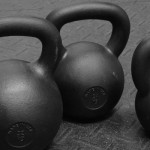
Although it may seem kettlebells are the latest fitness trend in gyms across the U.S., kettlebells have been around for over 350 years. Originally used by the Russians as a counterweight for measuring food sold at markets, this “cannonball with a handle” soon became a favorite training tool of the Russian Army. In the 1940s, the modern kettlebell gained even more popularity as Russia’s national sport. Today, kettlebells are used globally as a preferred training tool for several military services, athletic teams, and celebrities worldwide.
The kettlebell has found its place in the modern fitness world as people have come to discover the benefits of its function. Kettlebell training enhances strength, cardiovascular endurance, coordination, and flexibility. All things that well rounded athletes employ in their cross-training programs, but can also be utilized in daily activity.
Kettlebells are commonly associated with ballistic, swinging movements, but they are excellent tools for functional strength. Kettlebell movements require the body to recruit more than one group of muscles at a time, much like shoveling dirt in a garden would do. The legs, back, arms, and abdominals all work together to perform a short, intense repetitions. The structure of the kettlebell also lends itself to better functional strength, as well.
Unlike a traditional dumbbell with the weight evenly distributed on both sides of a lever (bar), a kettlebell’s handle is on top and the weight is centralized beneath it. This structure can be compared to everyday weight lifting challenges such as a shopping bag, a heavy purse, or a bucket filled with water. This also leads to greater grip strength, as well. Kettlebell training can help people learn how to move these day-to-day objects safer and more efficiently with improved strength.
Kettlebell ballistic movements such as swings, cleans, high pulls, and snatches are all explosive, powerful movements. When these signature movements are performed at a high speed, over short bursts of time, they can be very taxing on both the anaerobic and aerobic system yet beneficial for overall cardiovascular fitness.
Over the past 10 years, kettlebells have found a home with fans of high intensity interval training (HIIT). When used properly, kettlebell training in ballistic movements has shown to improve one’s anaerobic capacity (the ability to convert stored energy while working) and VO2 Max (the amount of oxygen utilized during intense exercise) in aerobic activity. Given these 2 benefits, most endurance athletes, such as runners, have incorporated kettlebells into their training programs, however, you can also expect to find yourself with a bit more energy when climbing the stairs or carrying groceries in from the car.
Since the majority of kettlebell exercises are total body, multi-joint movements, a greater amount of coordination is required for execution of the movements. When looking at sport specific movement, a vast amount of coordination and timing in the body is required to complete the required action such as running hurdles in track and field. Similar to learning how to properly run hurdles, kettlebell exercises are repetitious in nature and require the body to train a movement pattern instead of simply training an isolated muscle. By training this movement pattern with repetition through a movement like a swing, helps develop an innate sense of time and coordination in the body. This improves body awareness and can carry over into functioning in daily life.
Ballistic and grind kettlebell movements both require and improve overall flexibility. In ballistic movements, muscles are required to stretch and shorten at a quick pace. This displays dynamic flexibility, the range of motion that can be achieved by actively moving a body part using muscle action. Dynamic flexibility is important to the development of speed and power. Grind movements, such as a Turkish Get Up or a Windmill, also utilize dynamic flexibility even though the movements are slower in nature. As dynamic flexibility improves, regular tasks will feel less restricted and joints will feel more mobile.
Kettlebells are fantastic training tools for everyone from elite level athletes to people who are looking to lose weight and improve their level of fitness. Before starting a kettlebell routine, always check with your doctor to make sure it is safe for you begin a training program. It is also a good idea to seek out a trainer who is certified in kettlebell training to ensure that you are performing the movements with proper form, ensure that you are using a weight that is safe for you, and guide you in a program that is best suited for your personal goals.
For more info about kettlebells, please visit:
- www.dragondoor.com
- www.kettlebellscience.com
- www.kettlebell-athletics.com
- www.kettlebellconcepts.com
- www.usgsf.com
Kat Barrett, NSCA-CPT
Kettlebell Athletics Certified Instructor
Comments are closed.